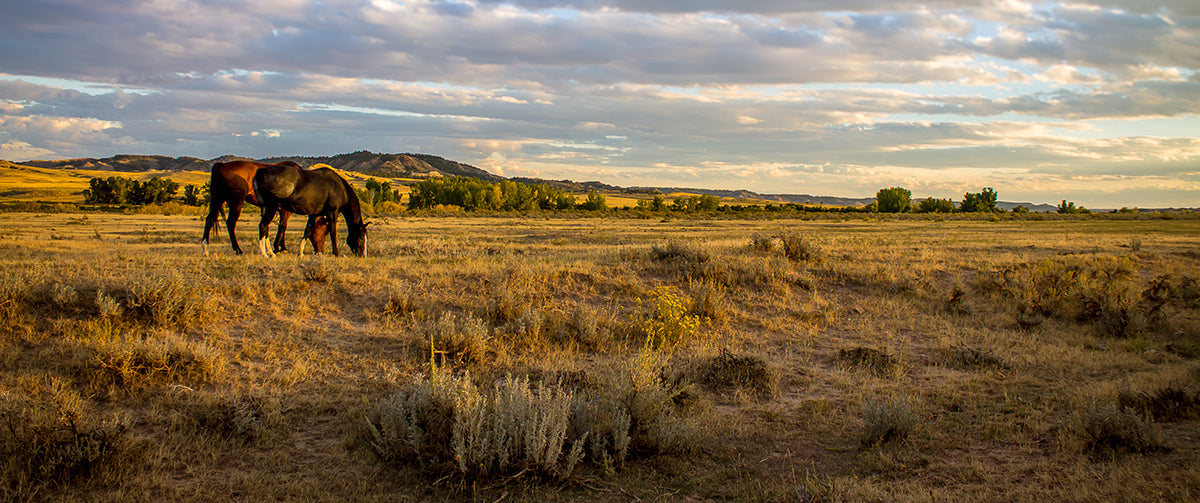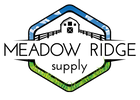
A Well-Planned Wood Horse Fence Adds Security, Safety, And Value To Your Property.
Fencing of any type—whether needed to confine animals, provide privacy, or define boundaries—represents a large monetary investment in your property. Carefully planning your next equine fencing project will ensure that your time and money are spent wisely on fencing that will satisfy your needs for years to come.
An effective horse fence allows for controlled grazing and segregation of animals in addition to its most basic purpose: keeping horses contained in designated areas of your property and away from dangers like roadways or nuisances such as unwanted visitors.
Of course, the true test of a fence’s worth is not when horses are peacefully grazing, but when an excited horse contacts the fence in an attempt to escape or because he never saw it in the first place. Wood post-and-board fences appear to a horse as a solid barrier, making these fences much less likely to be challenged or accidentally run into.
Your fence says a lot about your property—and your operations. Poorly planned, unsafe, or unmaintained fences detract from an equine facility’s value and suggest inferior overall management. Remember: your fencing is one of the first things visitors will notice as they approach your property. Be sure yours makes the very best impression possible through careful planning and using quality wood fencing materials.
What Makes A Great Horse Fencing Project? Designing For Function And The Future.
Effective horse fencing requires development of an overall plan that takes into consideration facility management practices, chore efficiency, safety, aesthetics, and budget. Now is the time to make the decisions regarding how your property will be used by establishing paddocks, pastures, lanes, corrals, and other functional areas.
Whether your plan is to install new enclosures or replace old, worn-out fences, the best fencing results will start with a layout drawn to scale that shows proposed gates, fence lines, stream crossings, traffic routes for horses and vehicles, access for mowing equipment, existing buildings, and other current features that will impact your design.
Terrain plays a big part in layout. Some areas of your property may not support adequate grass growth for grazing; other areas may suffer from poor drainage, resulting in chronic wet areas that can become messy eyesores. Consider using fences to confine horses away from unsuitable sites such as swampy areas and streams, and to fence off potential safety hazards such as trees.
Most horses in equine facilities are provided supplemental feed in addition to pasture grazing, so the amount of acreage required per horse is less relevant. Instead, acreage requiring enclosure depends on the number and size of paddocks needed for exercise, and space desired for riding areas.
Well-planned equine fencing allows for ease of management—moving horses from place to place, removal of manure, mowing, etc. Turnout paddocks ideally will be located near stables to make for easier movement of horses back and forth. It’s important that any vehicles needing to access the area be considered. Run-off from horse manure can be a pollutant; removal of manure from the site for storage elsewhere requires regular vehicular access to enclosed areas. Other daily operations will require field equipment to maneuver easily through gates to avoid damage to the fence and reduce the time required to accomplish work in the field. Further, plan for occasional upkeep like mowing, trimming, repairs, and painting. All these activities can be made easier through good decisions during the initial fence design process.
The fence must be tall enough to discourage jumping and solid enough to discourage testing its strength. Horse fences should be 54 to 60 inches above the ground. A good rule of thumb is that the top of the fence is at least shoulder height of the largest horse you are fencing in. Make sure the horse cannot climb the fence, and that social (and anti-social) interactions over the fence will not lead to injuries. Adding eight inches of clearance on the bottom will avoid leg and hoof entanglement and allow small animals such as rabbits to escape. Open spaces between boards should be small enough to prevent a horse from poking its head through, or large enough that the head not become caught.
Finally, make sure you check for any local zoning ordinances or other stipulations that will impact the design of your fencing project.
Special Fencing Situations
The best fence configuration differs from facility to facility and even within a horse property. A variety of wood horse fencing styles can be installed to meet the objectives of the enclosure. Here are three common examples.
In double fencing, each paddock has its own fence with an alley between. This fencing scheme eliminates social and anti-social activity over the fence and is frequently used with stallions and very valuable animals. Double fences can also discourage contact with humans. The first fence keeps the horse in; the second one keeps unwanted visitors away from direct horse contact.
Perimeter fencing is an effective way to ensure that loose horses cannot leave the property, which becomes more important as traffic and neighbors increase around a horse facility. Perimeter fencing surrounds the entire complex, filling the gaps at the end of access lanes and often surrounding the public entry point of the facility. A perimeter fence can also keep human and canine intruders away from the horses. A perimeter fence does not have to be of the same construction as paddock or pasture fence since it should have limited contact with unsupervised horses, but it should be visible and strong.
Electric fencing can be easily added to your post-and-board fence to deter horses from leaning against the fence, chewing on it, or reaching over the top to graze. Electric fencing creates a psychological force that makes horses think escape is either too formidable or impossible.
Electric fence systems include a charge that dispenses a high-voltage, low-amperage current, which is carried along the fence via a conductive wire. When an animal touches the wire, it gets an unpleasant jolt. The charge is powerful but short; enough to get the animal’s attention without causing injury. Modern controllers have the capacity to power long distances of fences.
Electric fences are easy to install, have low initial cost and are cheap to operate. This inexpensive addition can increase the effectiveness and life of your new fence. Installation how-to videos and information are available online or check your County Extension Office for resources.
Keep Things Moving With Gates
Horses tend to congregate around gates, so make sure these important elements of your fence are highly visible, sturdy and safe. The most common gate materials are wood and welded steel tubing, which easily satisfy these three requirements; avoid any fabrication that results in sharp edges that can potentially cut and snag hides.
Horses require gates at least four feet wide. Pasture fences should include a gate 14 to 16 feet in width, which will allow horses and equipment such as tractors, mowers, fertilizer trucks and wagons, to get into the pasture. Many horse operations locate their gates in order to allow a straight path through the gate for vehicles that are towing equipment, avoiding the added width required to make a 90-degree turn to get into the field.
Gates are often hung to swing both ways—in and out of the enclosure—and this feature is helpful when moving horses. Gates that open into lanes between enclosures should be the same length as the width of the lane so that the gate can be used to close off the passageway to help direct horses that are being moved.
Ideally, a person should be able to operate the gate—unlock, swing open, shut and re-lock—with only one hand, leaving the other hand free to lead a horse or carry a bucket.
Wood: The Natural Choice For Your Horse Fence
Horses will bolt suddenly in response to perceived danger. With their size and speed, they can hit a fence with great force, so strength and visibility are important considerations when choosing your fencing materials. Don’t make the mistake of choosing cheaper, but unsafe, horse fence materials such as galvanized wire or barbed wire, which can lacerate skin and cause entanglement.
Traditional wood fencing continues to be the popular choice for agricultural fencing, in particular on horse farms. With its attractiveness and strength, wood is highly prized for corrals, pastures and perimeter fencing near roadways and other trafficked areas.
Typically constructed of three or four evenly spaced wood planks screwed or nailed between wood posts, wood post-and-board fencing is highly visible, allowing horses to easily see boundaries.
Pine lumber used in many horse fences is sustainably harvested across much of the Midwest and southeast United States and provides superior fastener-holding power and load-bearing capacity. Pressure-treated pine is an ideal choice for areas that are moist, like barnyards. Pressure-treated wood undergoes an infusion of EPA-approved chemicals into the lumber to prevent the growth of bacteria or fungi and repel insects. Pressure-treated pine is highly rot- and decay-resistant, often lasting for 40 years—even when in contact with wet soil. This option also comes with a warranty against decay or insect damage in most cases.
Pine boards have a very natural, appealing color that, uncoated, will turn a golden brown over time. Many property owners also choose to paint their enclosure to complement their surroundings. In addition to enhancing the classic and uncomplicated nature of a wood horse fence, regular painting maintenance helps preserve the fence’s wood and good looks for a longer life.

The most time-intensive phase of a fence project takes place before any ground is broken. Effective horse fencing requires development of an overall plan that takes into consideration facility management practices, chore efficiency, surrounding terrain, existing features, safety, aesthetics, and budget.
Thoughtful fence planning and layout will help make daily chores and routines more efficient and takes into consideration future operational needs. By understanding your priorities, needs, and expectations, you can design a safe, functional fence that will provide years of service and enhance your property's value.
Post-and-board wood fences provide the vital functions of containment and safety, while adding the rustic, natural look that appeals to most property owners. Durable, strong, and beautiful, pine wood fencing is the right choice for your next corral, pasture, or other agricultural enclosure.
Renewable and responsibly harvested wood, like the pine fencing materials from Meadow Ridge Supply, is a choice you can feel confident about.
Meadow Ridge Supply is a convenient, one-stop spot for quality pine lumber that is gathered, milled, and pressure treated in Michigan.
Pine Posts & Slabs
3 ½ inch to 8 inch diameters / 6 ½ feet to 14 feet lengths
Boards (Rough Sawn or Smooth)
1 inch x 6 inch x 16 feet
Whatever the size and scope of your fencing project, let Meadow Ridge Supply help you make the right statement on your property with Michigan pine fencing materials. It’s the natural choice.
Contact us today! Our expert wood fencing representatives can answer your questions and help you choose the right products to meet your needs.
Phone: 989-750-0750
Email: info@meadowridge.supply
REFERENCES:
https://extension.psu.edu/fence-planning-for-horses
https://www.extension.iastate.edu/equine/fencing-horses
https://extension.uga.edu/publications/detail.html?number=B1192&title=Fences for Horses
https://extension.uga.edu/publications/detail.html?number=C774
